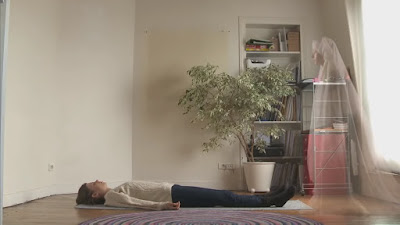Jean-Claude
Brisseau
In
Memoriam
According to reports from
the French mainstream media, filmmaker Jean-Claude Brisseau has passed away. A
controversial figure in contemporary cinema, Brisseau had a style and
sensibility that was singular, provocative and often charged with the
supernatural. As an early disciple of Éric Rohmer, Brisseau shared his mentor's
affinity for scenes of leisurely conversation, where set-pieces would often
consist of two characters sitting down in a park or public space to discuss
their relationships, the world and the mysteries of the universe. Unlike Rohmer's
films however, such scenes were often punctuated by moments of brutal violence,
a reverence to genre and explicit sexuality.
My introduction to Brisseau's
cinema came in 2014 when I saw his penultimate feature, The Girl from Nowhere
(2012). I can't remember what it was that brought the film to my attention but
I do remember reading a plot synopsis and finding similarities to two of my
favourite films from the same period: Lady in the Water (2006) by M. Night
Shyamalan and Ondine (2009) by Neil Jordan. I've always had a personal interest
in films about mysterious characters coming into contact with protagonists that
have given up on life, and in doing so, bestow upon them a renewed sense of
purpose. Added to this a particular fondness for films that deal with myths and
miracles from a semi-plausible perspective and The Girl from Nowhere seemed a
sure thing.
The Girl from Nowhere [Jean-Claude
Brisseau, 2012]:
With its phantoms and its haunted
memories, its strange encounters and premonitions, its relaxed conversations
and discussions on art, the cinema, loneliness and grief, to say nothing of its thread of self-reflexivity, in which the protagonist's attempt to commit his
memories to the page creates a subtle mirroring between the content of the
character's text and the fantastical story unfolding on-screen, The Girl from
Nowhere remains a fascinating and distinctive work. With its micro-budget
aesthetic, its use of the director's own apartment as the principle location
and its homemade special-effects, it also provided a template for my own work
and the kind of films I wanted to make but never did. To this day, an image from The Girl from Nowhere sits at the top of
this very blog and provides a kind of shorthand for the type of cinema I find
most bewitching.
Brisseau made other films that
I love just as much as The Girl From Nowhere. Sound and Fury (1988) - which
takes its title from a quotation from Shakespeare's Macbeth and has a similar
juxtaposition between power structures, violence as a means to an end and the
supernatural - finds the filmmaker following a line of influence from The 400
Blows (1959) to L'Enfance Nue (1968) with another film about a childhood on the
fringes unravelling into brutality. In this film, Brisseau makes his first
great leap in the aesthetic union between social-realism and poetic-realism, setting
a template for the concerns and images that would come to haunt his later, more
controversial features, such as Céline (1992), The Black Angel (1994), Secret
Things (2002), The Exterminating Angels (2006) and À L'Aventure (2008).
Each of these films could
be described as mysterious, hypnotic, classical and provoking, and would be more
than worthy of a full, essay-length analysis of their respective strengths and
weaknesses, and how well they deepen and enrich the political, aesthetic
and metaphysical dialogues that run throughout Brisseau's work. In lieu of this kind of tribute please accept this small gallery of images taken from my favourite of Brisseau's
films.
A Brutal Game [Jean-Claude
Brisseau, 1983]:
Sound and Fury [Jean-Claude
Brisseau, 1988]:
Céline [Jean-Claude
Brisseau, 1992]:
Workers for the Good Lord
[Jean-Claude Brisseau, 2000]:
The Exterminating Angels [Jean-Claude
Brisseau, 2006]:
À L'Aventure [Jean-Claude
Brisseau, 2008]:
The Girl from Nowhere [Jean-Claude
Brisseau, 2012]:
Let the Devil Tempt Us [Jean-Claude
Brisseau, 2018]:
Brisseau's final
feature-length film, Let the Devil Tempt Us, was released last year (re-titled
for English speaking audiences as the less compelling "Tempting
Devils"). Understandably, sexual harassment allegations brought against
Brisseau following the release of his scandalous but hugely successful late-feature,
the aforementioned Secret Things, effectively ended his reputation as a
respectable filmmaker of merit. Outside of France his work has drifted into
obscurity. Very few (if any) English-speaking media outlets have mourned his
passing, or used the occasion to open up avenues of discussion surrounding his
work. While one must treat allegations of sexual misconduct with the upmost
seriousness and concern, the attempts to suppress the films of Brisseau - or
those by Roman Polanski, Woody Allen, Šarūnas Bartas, etc, etc. - seem
reactionary, if not totalitarian, and do a great disservice to the many actors,
technicians and collaborators who contributed to these works, and especially to
the films produced prior to such allegations being made.
When groups talk of
inclusivity, they often refer to social justice issues regarding
representation. More female voices, more transgender voices, more voices from a
non-white, non-western background. Such ideals are laudable and worth fighting
for. But true inclusivity is also acknowledging that great art can be produced
by anyone. From the most virtuous saint to the lowliest sinner, each of us has
a story to tell, and a way of looking at the world that is unique, distinctive
and possessing of our own inherent truth. Art is a way of looking at the world
through different perspectives. Whether the artist comes from a place of vice or
virtue, we can still learn something from seeing the world from their particular point of view.












